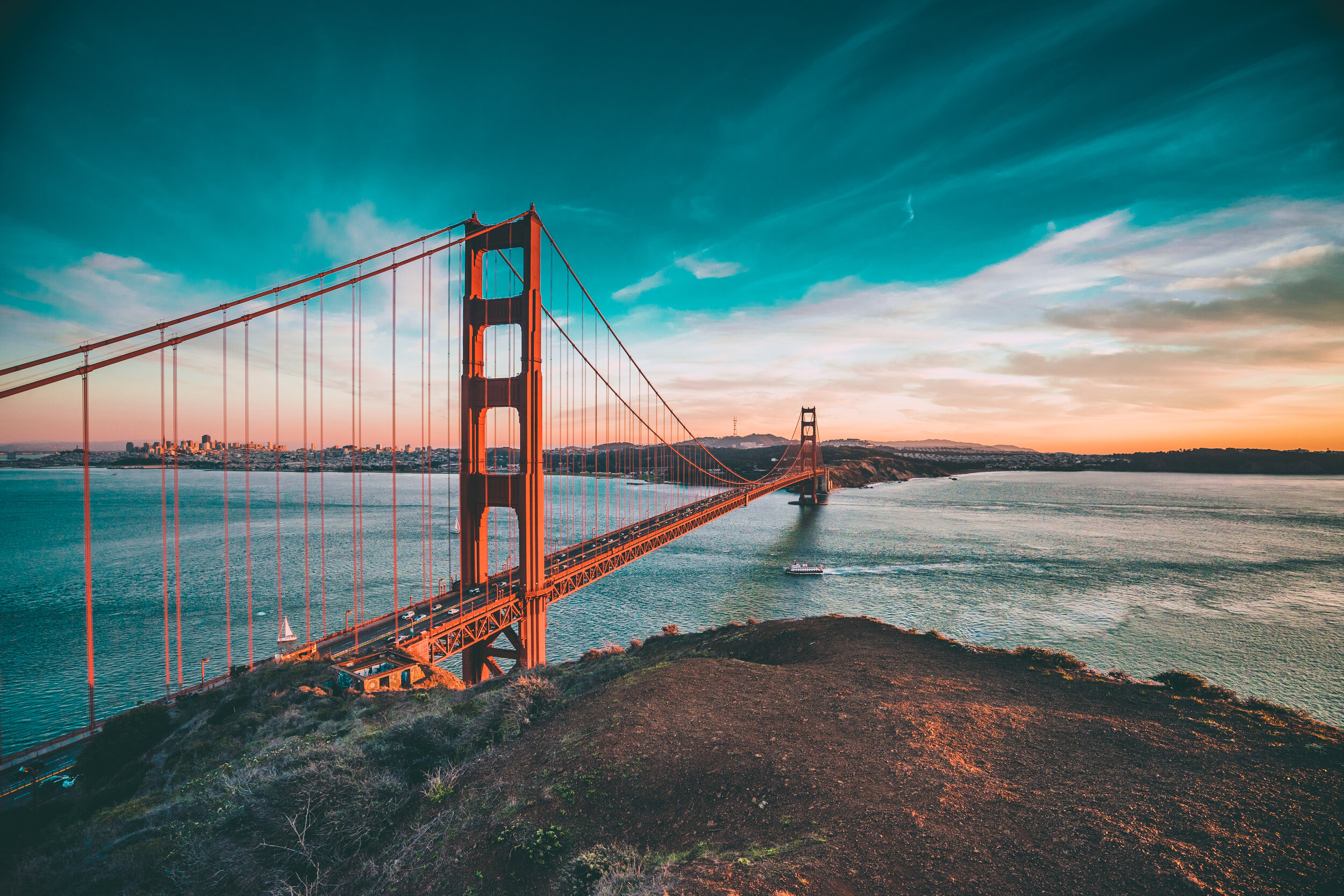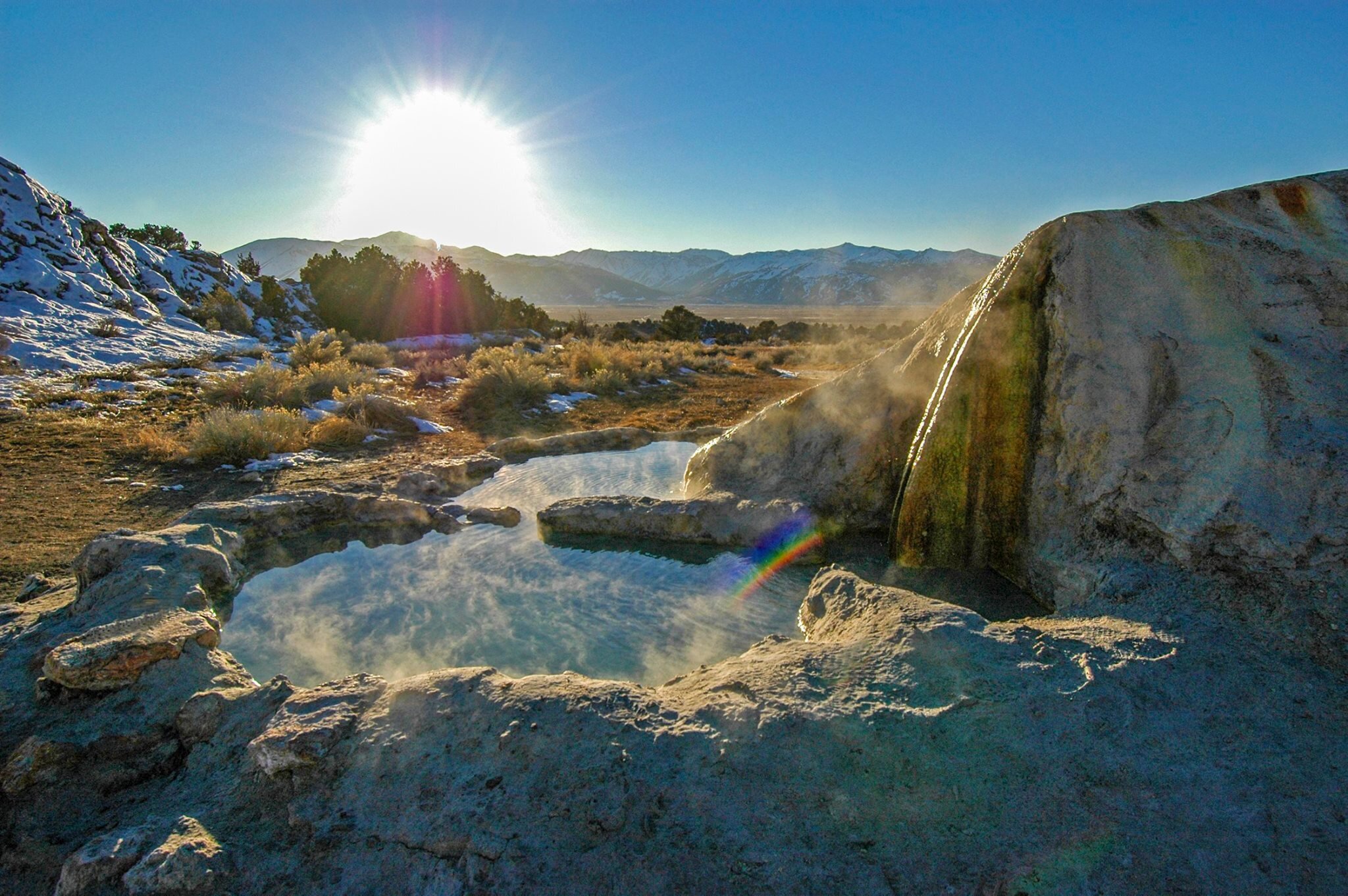California is a road trippers paradise. From sandy beaches to towering sequoia trees, foggy coastlines to desert oases, the scenery changes so quickly you can spend countless trips here and not see the same thing twice. And while we most often think of road tripping along the coastline, or going inland to popular areas like Yosemite, Sequoia, and Joshua Tree National Parks, there aren’t many times that you see people taking the route on the eastern side of the state.
One of our favorite California road trip routes takes you from Lake Tahoe south on Highway 395 on the eastern side of the Sierra Mountains, east through Death Valley, and lands you in Las Vegas. With gorgeous mountain views, hot springs, and abundant adventure activities, this lesser traveled California road trip will not disappoint.
10-Day Eastern Sierra California Road Trip
Day 1: San Francisco
Do: Fly into San Francisco and begin your trip in the City by the Bay. Explore the many eclectic neighborhoods, like the Mission District and Noe Valley, and popular tourist destinations like Fisherman’s Wharf, Lombard Street and Telegraph Hill. Rent a bike to ride across the Golden Gate Bridge and have lunch or dinner at the water front hang out, Bar Bocce, in Sausalito.
Stay: A popular hotel district is the Union Square area, but we recommend getting on the outskirts to avoid the major tourist area. Check out Nob Hill, you’ll find higher-end places like the Fairmont as well as small, three-story hotels that feel more like apartments.
Day 2-3: Lake Tahoe
Do: Drive to the stunning Lake Tahoe area. Although South Lake is the popular tourist attraction, we highly recommend exploring the north and west shores instead. Start in Truckee, a charming old railroad town set in the Sierras, and the perfect gateway to the Tahoe area. Fish the Truckee River, stroll the streets of Historic Downtown, and take a hike for views of Donner Lake. Make your way to Tahoe City or Kings Beach, located on the shores of Lake Tahoe. On your way you’ll pass popular ski resorts like Squaw Valley (home of the 1960 winter Olympics) and Alpine Meadows. Squaw Valley is a great stop for lunch, drinks or a gondola ride!
Once you’ve made it to the lake, you’ll find many options for hikes, like the short hike to Eagle Rock for gorgeous views of the lake, as well as water activities, like stand up paddleboarding and kayaking.
This also gives you a chance to drive along the west shore of the lake on your way south to your next destination and pass by beautiful scenery like Emerald Bay. You will go through South Lake Tahoe so you can stop and pop a quarter in the slot machines if you’ve got the urge.
Stay: Truckee has several great campgrounds and RV parks. One of our favorites west of Truckee is Hampshire Rocks Campground, as it sits right on the South Yuba river. Closer to town there are a few campgrounds in between Truckee and Tahoe City, Granite Flat, Goose Meadow and Silver Creek that run along the Truckee River, but also close to a busy road. Another great option are the campgrounds at Donner Lake, although they fill up quickly in the summer months. Once you make it to the shore, try Emerald Bay, Sugar Point State Park or TSRA campgrounds, but do book in advance.
Day 4: Bridgeport
Courtest of monocountry.org
Do: Head south from South Lake Tahoe on the scenic route. Make your way through open meadows and wildflowers to Markleeville before continuing your drive south on Highway 395. A good stop is the town of Bridgeport.
A popular spot in Bridgeport is Travertine Hot Springs. You can choose from 5 pools, including a large man made pool near the parking lot or more natural tubs just a short walk down the trail. With beautiful mountain views and interesting geology near the tubs, this is a must-do on your drive.
Buckeye Hot Springs is another option, although a bit more of a drive off the highway.
Stay: If you’re looking for an RV Park, Paradise Shores is a great spot on the shores of Bridgeport Reservoir, or you can pull just off the highway at Bootleg Campground or Chris Flat Campground if you’re looking for a quick stopover. Another option is to camp on BLM land (for free!) on the road leading to Travertine Hot Springs or Buckeye Hot Springs. There is limited space here, and you’ll have to pack everything in and everything out. We love this option because you can visit the Hot Springs at sunset or sunrise, and time it so you have the tub all to yourself.
Day 5-6: Mammoth Lakes
Do: Your drive south takes you by Mono Lake, June Lake and finally to Mammoth Lakes. Mono Lake is one of the oldest lakes in the Western Hemisphere formed at least 760,000 years ago! It is a saline soda lake, due to its lack of outlet causing high levels of salt to accumulate. Look for the eerie tufa towers, mineral structures created when fresh-water springs bubble up through the alkaline waters of the lake.
The town of June Lake is a great place to stop for a bite or a beer, or to stretch your legs with a nice hike. The area itself contains four lakes surrounded by a dramatic mountainous backdrop, so the views alone are worth a drive through here. During the winter, June Mountain welcomes skiers and snowboarders, drawing many California families as kids under 12 ski and ride for free! During the summer, you’ll find great hiking trails, rock climbing, and activities on the lakes, like boating, canoeing, and swimming. We recommend stopping at June Lake Brewing.
Mammoth Lakes is a year-round adventureland. With a name like Mammoth, you can assume the size of the mountains and expanse of the valleys. Plus, the number of crystal clear mountain lakes makes this place a beauty you have to see to believe. From mountain bike rides to fly fishing in the summer, to epic skiing and snowboarding in the winter, and much, much more. Plus, this mountain town is full of charm, and great places to eat and drink all year.
Outside of town, there are many hot springs to choose from, like Wild Willy’s Hot Spring. You can’t beat the views while soaking in these tubs.
Stay: There are plenty of established campgrounds to choose from in town, as well as just outside, like Camp High Sierra, New Shady Rest Campground, and Sherwin Creek Campground (just to name a few). The Mammoth Mountain RV Park is located right at the entrance to town and provides hook-ups year round. But our favorite spot to camp is on BLM land outside of town near Crab Cooker Hot Springs.
Day 7: Alabama Hills
Do: Continue on 395 south towards Bishop, where you can stop at Erick Schat’s Bakery for some breakfast pastries or sandwiches. Bishop is a popular destination for climbers, particularly for bouldering. Even if you aren’t into climbing, a drive to the popular Buttermilk Boulders is worth it. These massive boulders cover the ground here, with a gorgeous mountain back drop. Just thinking about attempting to climb these things (without a rope!) is enough to get your palms sweating.
Next on your route is the town of Lone Pine. You’ll notice this is a great place to stock up on supplies, as many hikers from the Pacific Crest Trail make the trek here to resupply. Head west towards Mount Whitney to Alabama Hills. Here you’ll find a surreal scattering of massive boulders and arches.
Stay: Alabama Hills dispersed camping is a great spot to camp for the night. You can park your vehicle next to a large boulder, facing massive mountain views. This camping is free, with no amenities, so make sure to bring everything you need in with you. It is also a popular destination on the weekends, so do get there early.
Day 8: Death Valley National Park
Do: On your way out of town, Alabama Hills Café and Bakery is a great stop for some down home breakfast. Today you’ll start heading east as you make your way through Death Valley National Park.
A major highlight in Death Valley is a trip to Badwater Basin. Sitting at the lowest elevation in North America (-282 feet), this otherworldly salt flat is a must-see. For a scenic drive, take your vehicle through Artists Drive to view a patchwork of multicolored, eroded hills, and end at the Artists Palette viewpoint for some of the most photogenic sections of the park. Star Wars fan? Take a tour of all the filming locations located throughout Death Valley.
Stay: There are several campgrounds located within the park, like Furnace Creek, Sunset, Texas Springs and more. Most don’t take reservations, meaning they are first-come, first-serve, so make sure to head to the campground as early as you can to grab a spot. Furnace Creek is the only option that takes reservations part of the year (and has full hookups), but they fill up fast so try to reserve far ahead of when you plan to arrive.
Day 9: Red Rock Canyon
Do: Continue to Red Rock Canyon National Conservation Area, located just 17 miles west of Las Vegas. Open year round, this area houses over 30 miles of hiking trails, as well as rock climbing, a spectacular 17 mile drive, and over 10,000 years of human history. Many tours are available or you can download a trail map here to find detailed information on 26 hikes and trails.
Stay: There is one developed campground located within Red Rock Canyon, Red Rock Canyon Campground and is a great spot, although limited in terms of amenities. We recommend staying here so you are close to activities and features within the area.
Day 10: Las Vegas
A short drive takes you to Sin City to return your RV. Spend the day walking the Strip, hitting up the casinos, taking in a show, and eating at world-class restaurants. Unwind after your trip at the spa or just relax at one of the hotel pools. Spend the night here or fly home.
Stay: Hotel options are endless in Vegas, so you really can’t go wrong! The MGM Grand is a popular destination for families, while the Aria is a great option for couples.
Need help planning your next Eastern Sierra California Road Trip? We can help! Contact us now to get started.









